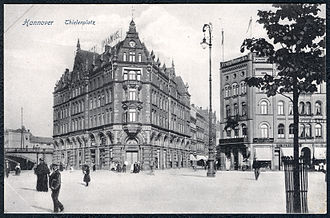Overlach's house
The Overlach'sche Haus in Hanover is today a composition of a residential and commercial building built in the late 19th century with the only stone facade of the city's 17th century bourgeois Renaissance architecture almost completely preserved . The listed building is located at Lavessstraße 82 in the Mitte district .
history
The building was originally built in 1663, a few years after the Thirty Years' War , by master bricklayer and stone carver Adrian Siemerding right next to the town's market church for the merchant Johann Overlach and his wife Anna Kleine . The wealthy couple had their building erected in “the best location”, as the market square was “the urban center and political and social center of the old town since the Middle Ages”. At the address Am Markt 6 , the comparatively powerful building, framed by two smaller side buildings, stood almost immediately next to the Marktkirche (the later part of the market square) on Hanns-Lilje-Platz until 1884 .

Postcard no. 101 of Georg Kugelmann , 1907
After the beginning of industrialization in the Kingdom of Hanover , the situation on the market square changed significantly in the middle of the 19th century: First, the city master builder Ludwig Droste subjected the market church to a thorough renovation. In the opinion of the time, this had to be accompanied by a “style adjustment” - “the church received a uniform neo-Gothic interior”. In the church tower the (today's) "large west portal with the tracery garments" was built in, all direct additions to the church walls, such as the "Ratsbuchbinderhaus", were dismantled "in favor of a uniform monumental effect" of the church.
The economic boom, especially after the founding of the German Empire , led to fundamental renovations and new buildings around the Overlach house in the 1880s. On the northern side of what is now Hanns-Lilje-Platz up to Kniehauerstraße , a closed row of brick houses with predominantly Gothic elements was built between 1884 and 1885 .
Around the same time, the banker and mayor August Basse had his own residential and commercial building built at Lavessstrasse 82 . While the new brick group at today's Hanns-Lilje-Platz was almost completed and the Overlach house was to be demolished in order to expand the space, Basse gave the order to put the facade of the Overlach house in front of his own house and thus preserve it for posterity. More than a dozen workers painstakingly dismantled the Renaissance building and the two adjoining houses in 1884, piece by piece, with breakneck manual labor. The parts of the Renaissance facade were meanwhile transported to Lavesstrasse by horse and cart.
literature
- Arnold Nöldeke : Solid and mixed buildings up to the second half of the 17th century. In: The art monuments of the city of Hanover , part 1, monuments of the "old" city area of Hanover , self-published by the provincial administration, Schulze's bookstore, 1932, (Neudruck Verlag Wenner, Osnabrück 1979, ISBN 3-87898-151-1 ), p. 444– 449, here especially p. 448
-
Ludwig Hoerner :
- Demolition of the houses at the corner of Bonehauerstrasse and Marktplatz, 1884. In: Hanover in early photographs. 1848-1910 , Schirmer-Mosel, Munich 1979, ISBN 3-921375-44-4 , p. 126f.
- the same: View of the tower of the market church and the market square, around 1888. In: Hannover in early Photographien ... , p. 116f.
- Gerd Weiß, Marianne Zehnpfennig: Town houses on the market square In: Monument topography Federal Republic of Germany , architectural monuments in Lower Saxony, City of Hanover, Part 1, [Bd.] 10.1 , ed. by Hans-Herbert Möller, ISBN 3-528-06203-7 , pp. 56f., as well as the middle annex . In: List of architectural monuments according to § 4 (NDSchG) (except for architectural monuments of the archaeological monument preservation) , status: July 1, 1985, City of Hanover, Lower Saxony State Administration Office - Institute for Monument Preservation , p. 3ff.
- Helmut Knocke , Hugo Thielen : Lavessstraße 82. In: Hannover Art and Culture Lexicon , p. 166f.
Web links
- Malte Woydt: Johan Overlach , genealogy of the descendants of the Hanover city governor to the botanist Johann Heinrich Burckhardt (1676–1738), last accessed on October 21, 2013
References and comments
- ↑ a b c Helmut Knocke, Hugo Thielen: Lavessstraße 82 (see literature)
- ↑ a b Gerd Weiß, Marianne Zehnpfennig: Town houses on the market square (see literature)
- ↑ a b c d Ludwig Hoerner: Demolition of the houses ... (see literature)
- ↑ a b Ludwig Hoerner: View of the tower of the market church ... (see literature)
- ↑ Arnold Nöldeke: Solid and mixed buildings ... (see literature)
- ↑ Note: Today's Hanns-Lilje-Platz belonged to the market square in the old town, which was named Am Markte from 1818 . In 1978 this part of the former market square was renamed after the regional bishop Hanns Lilje . Source : Helmut Zimmermann : Hanns-Lilje-Platz. In: The street names of the state capital Hanover , Verlag Hahnsche Buchhandlung, Hanover 1992, ISBN 3-7752-6120-6 , p. 105
- ↑ Waldemar R. Röhrbein : BASSE, (1) August. In: Hannoversches Biographisches Lexikon , p. 43; online through google books
- ^ Helmut Knocke: Siemerding, (1) Adrian. In: Klaus Mlynek, Waldemar R. Röhrbein (eds.) U. a .: City Lexicon Hanover . From the beginning to the present. Schlütersche, Hannover 2009, ISBN 978-3-89993-662-9 , p. 566.
Coordinates: 52 ° 22 ′ 27.3 " N , 9 ° 44 ′ 44.1" E
